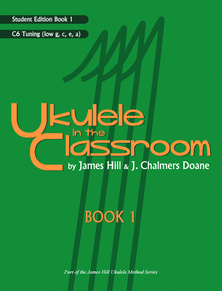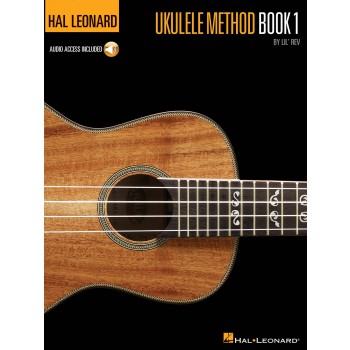
This is the one book that I've found that truly takes this instrument seriously, and focuses on music literacy rather than rushing to strumming songs. (We all do realize that you can play melodies on ukulele, right?) In fact, Book 1 does not even discuss chords until the last 10 pages of the book.
The series also comes with a teacher's edition. Score! A method book meant for what we do. One thing to note immediately, though - the Canadian music education system uses linear tuning rather than re-entrant tuning, so the 4th string is an octave lower than normally found in the mainland US, but the book says that it's "High G friendly," so we should be good to go! (More on that later...) They also prefer tuning the ukulele a full step higher than in the US (ADF#B). This last point is not that big of a deal, since they publish the book in both C6 tuning (US) and D6 tuning (CA). You just need to know to look for the version you want.
It it starts by teaching each string as notes to be read on the staff - string 4 & 3. The first reading exercise, in fact, is simply quarter notes playing C, G, C, G, etc. I like this approach, since I will often have students need to be reminded that it's an open string when they ask, "where's E again?"
Even better, it gets them singing while they play this simple exercise. They are encouraged to sing "Row, Row, Row Your Boat" as they alternate between the two notes. A very holistic approach altogether.
By page 8, students are playing duets! Not just one, but 5 different simple duets, all in the first unit. Singing and playing is encouraged all along as they go. I'm drooling by this point.
Unit two works on playing the full C Major scale, and using that scale to practice reading different rhythms; not just playing it on quarters, but 8 different rhythm patterns. (Dang, this is cool!) By the end of Unit 2, they've played several duets & trios, worked on learning intervals by letter names and by solfege, and discuss how to recognize these intervals in C Major. Oh, and Brahms. (I'm sweating.)
Unit three focuses on the F Major scale, and follows much the same format, but steps it up a notch, when students not only play a duet of "Long, Long Ago," but also learn how to fill out a variations on the melody as a solo player.
Unit 4 brings in chords, and only C, G, and F, respectively. It even gives specific strategies and exercises to slowly work those chords into the fingers, then gives students a melody to play while a friend plays the chords. This ends the book, but there's three more books in the series!
So this sounds like your perfect book for classroom ukulele, right? Why haven't I already started using it?
It's that darn linear tuning. The book says it's low-G friendly, and makes some gestures towards it at the very beginning (giving greyed-out alternate high-G notes), but that disappears almost immediately, and it's obvious that it's written for low-G in mind.
That's not to say that I'm not still considering it, but I love the re-entrant sound, and that high-G fourth string does offer some cool options in ensemble and solo playing. Linear tuning sounds too much like a guitar to me. When I want a guitar sound, I pick up my guitar.
But that's my bias, and I'm trying to decide whether or not I need to get over it. The fact is, though, that when students leave my room and purchase a ukulele, it's likely going to be re-entrant, unless they buy in Hawaii, Canada, or change the strings and nut to fit linear tuning. (I do have a student who bought her ukulele in Hawaii, and it's linear tuning...)
On the other side of things, I'm using ukuleles right now in my sixth grade chorus. As an effort to break them of the habit of learning their notes by ear and by associating them with words, I'm having them learn to play their choral parts on ukulele. Of course, I have to make sure that none of the music goes below Middle C to do this - unless I switch the instruments to Low-G.
So there you go. As with all of these books, it's a decision you will need to make as a teacher, based on what you want to accomplish in your classroom, and how much time you have to do it. This would be an ideal book for a long-term ukulele class - semester or full year.
Check out the other resources on the Ukuleleintheclassroom.com website. There are free resources, ukulele ensembles, and all sorts of neat stuff there.
Between James Hill and Walk Off the Earth, there's days that I start thinking about heading north...there's cool stuff happening up there!
Positives:
Comprehensive method book designed specifically for classroom
Includes teacher edition with lesson plans
No Tablature
Includes solo melodies & duets
Waits until other skills are firmly in place before introducing chords
Weakness(?):
Low-G based

 RSS Feed
RSS Feed
